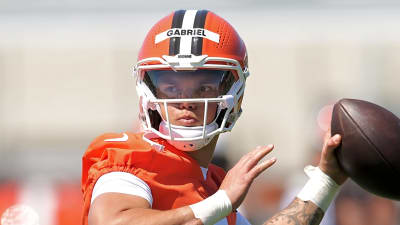
Andrea Petkovic explained the differences in the Canadian Open tennis balls, asserting that the change is as profound as "going from clay courts to grass courts." She believes this is the main reason for the constant unforced errors and the significant number of double faults that have been seen in the matches.
The Canadian Open is a tournament that has often provided surprises. In fact, just a year before, it had an unprecedented men's champion in Alexei Popyrin, who wasn't even among the seeded players.
This time, we have again seen surprising upsets, and errors have been abundant. The most emblematic case is probably that of Coco Gauff, who had a total of 37 double faults in her two matches against Danielle Collins and Veronika Kudermetova, and another five against Victoria Mboko.
“In short, keep a grip on your serve"
The former world No. 9 commented on the state of the balls in Canada—in both Toronto and Montreal. The German said on her Substack that the switch to Wilson balls is key to the issue. "If you have wondered why some of the matches haven’t been up to par in terms of quality, particularly in the first few rounds – we’ve seen double faults en masse, we’ve had unforced errors in bulks – well, what the clay to grass change is in surface is the Slazenger to Wilson switch in tennis balls."
“From the heaviest to the lightest within days and not only that, while the Slazenger ball fluffs up when it gets played the Wilson ball (unless it’s very humid) becomes almost bald."
“So, from having full control over where shots are going with the Slazenger and potentially having to go down in string tension to ensure you have enough depth against the best in the world, you now struggle to keep a grip on your serve, groundstrokes and, of course, your sanity.
“Once the sanity is gone, the good tennis is right there with it, following sanity like a loyal puppy," the former top-10 added. “In short, keep a grip on your serve if you want to keep a grip on your sanity. She’s a fickle, little monster.”
"These balls are for sure the hardest balls to control": Taylor Fritz weighs in
The American No. 1, Taylor Fritz, had already expressed his dissatisfaction with the balls. The world No. 4 maintained a first-serve percentage below 55% in his first two matches against Roberto Carballés Baena and Gabriel Diallo, although he survived both with straight-set victories.
“I think these balls are for sure the hardest balls to control that we play with all year, the Wilson US Opens. And they’re not bad, it’s just the balls that we’ve been playing with on tour for the last couple years consistently the most, they’re just really soft and more dead.
“So they slow down off the bounce, they hold on your strings longer, there’s just like a more soft, dead ball we play with. You play with these, they shoot off your racquet, they jump off the court faster.”
The second seed will face Czech player Jiri Lehecka (19th seed) in the Round of 16 in a bid to reach the tournament quarterfinals. If he advances, he will be met in the Round of 8 by the Russian world No. 11 Andrey Rublev, who advanced after Alejandro Davidovich Fokina retired due to injury. Rublev is defending the final he reached in 2024, where he fell to Popyrin.
More must-reads:
- Novak Djokovic sparks major concern ahead of U.S. Open
- Yankees quickly pull plug on key trade-deadline acquisition
- The 'MLB playoff home run leaders' quiz
Breaking News
Trending News
Customize Your Newsletter
 +
+
Get the latest news and rumors, customized to your favorite sports and teams. Emailed daily. Always free!








